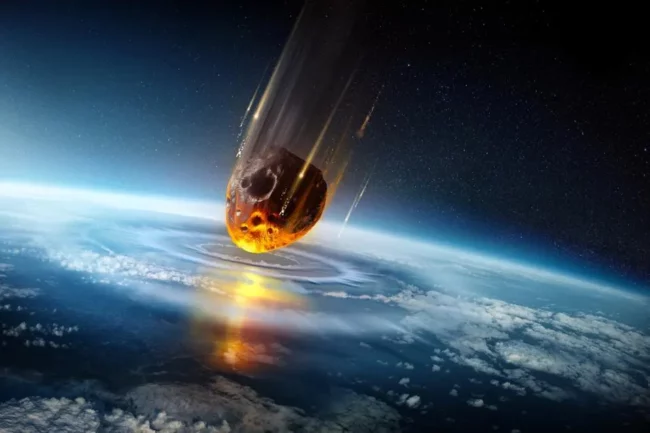The likelihood of asteroid 2024 YR4, dubbed a ‘city-killer,’ colliding with Earth has dropped to near zero, according to updated assessments from NASA and the European Space Agency (ESA).
Tribune Online reports that a scientist at NASA’s Catalina Sky Survey Project, David Rankin warned that a massive asteroid, 2024 YR4, could potentially collide with Earth in 2032, with a risk corridor spanning nine countries, including Nigeria.
The space rock, which was last week considered the most significant asteroid threat in two decades, now has a 0.0017% chance of impacting Earth in December 2032, NASA stated on Monday. The ESA’s risk assessment is similarly low at 0.002%.
NASA explained that this translates to a 1 in 59,000 possibility of impact, meaning there is a 99.9983% chance that the asteroid will pass safely by Earth in seven years.
The agency further noted that while the asteroid previously had a 1.7% chance of hitting the moon, this poses no risk to Earth.
“When first discovered, asteroid 2024 YR4 had a very small, but notable chance of impacting our planet in 2032,” NASA stated. However, as more observations were submitted, experts at the agency’s Jet Propulsion Laboratory’s Center for Near-Earth Object Studies refined their calculations. “Now [they] have found there is no significant potential for this asteroid to impact our planet for the next century.
The latest observations have further reduced the uncertainty of its future trajectory, and the range of possible locations the asteroid could be on Dec. 22, 2032, has moved farther away from the Earth.”
Over the weekend, the asteroid’s ranking on the Torino Impact Hazard Scale, which categorises potential collisions of space objects with Earth, was downgraded to 0 out of 10. This means the likelihood of impact is effectively zero.
Asteroid 2024 YR4, which was first detected by telescopes on 27 December 2024, measures between 40 and 90 metres in width—comparable to a large building. If it were to collide with Earth, it could cause significant local devastation.
The rapid reduction in risk assessment is due to “unsung, meticulous work by astronomers” conducting follow-up observations using telescopes worldwide, according to Richard Binzel, inventor of the Torino Scale. “I’m pleasantly surprised that we could reduce the probability numbers so quickly,” he said.
Early last week, 2024 YR4 briefly surpassed the threat level once posed by asteroid Apophis, which in 2004 had a 2.7% chance of hitting Earth. At its peak, 2024 YR4 reached a ranking of 3 on the Torino Scale, with a 3.1% estimated impact probability according to NASA and a 2.8% risk according to the ESA.
The discrepancy between NASA and ESA’s initial calculations stemmed from differences in the tools used to determine the asteroid’s orbit.
However, astronomers anticipated that the risk level would drop as additional data became available. The same trend occurred with Apophis, which was once considered one of the most hazardous asteroids but was later downgraded to pose no threat to Earth within this century.
Astronomers face challenges in assessing newly discovered asteroids due to uncertainties in their size and orbital paths. In the case of 2024 YR4, follow-up observations conducted in February under optimal dark-sky conditions helped refine calculations and reduce uncertainty.
Key telescopes contributing to the latest findings included the Canada-France-Hawaii Telescope, the Subaru Telescope, and Haleakala-Faulkes Telescope North in Hawaii, as well as the Magdalena Ridge Observatory in New Mexico, the Gemini South Observatory in Chile, Arizona’s Lowell Discovery Telescope, and the Nordic Optical Telescope in the Canary Islands.
ALSO READ: Nigeria, eight other countries at risk of ‘city-killer’ asteroid impact — NASA scientist
David Tholen, an astronomer at the University of Hawaii’s Institute for Astronomy, explained the significance of Hawaii’s role in these observations. “The atmosphere above Maunakea tends to be very stable, and it enables telescopes to produce very sharp images, sharper than most other observatory locations,” he said.
The updated risk assessment comes just in time. Astronomers had been concerned that the asteroid’s trajectory would take it beyond the reach of ground-based telescopes from April until June 2028, limiting further observations.
Despite the latest findings, astronomers remain cautious and plan to continue monitoring the asteroid to confirm its trajectory. The James Webb Space Telescope is scheduled to observe 2024 YR4 in early March, which could provide further insights into its exact size and orbit.
ALSO READ TOP STORIES FROM NIGERIAN TRIBUNE
WATCH TOP VIDEOS FROM NIGERIAN TRIBUNE TV
- Let’s Talk About SELF-AWARENESS
- Is Your Confidence Mistaken for Pride? Let’s talk about it
- Is Etiquette About Perfection…Or Just Not Being Rude?
- Top Psychologist Reveal 3 Signs You’re Struggling With Imposter Syndrome
- Do You Pick Up Work-Related Calls at Midnight or Never? Let’s Talk About Boundaries







